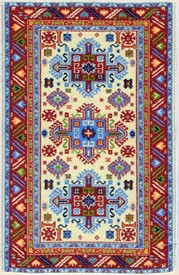By Alison Gardner
Rugs and carpets have been part of my life forever. More or less functional, more or less attractive rectangles and circles defining my room space and comforting my step. However, after my recent visit to Turkey, I view them with fresh eyes: I have discovered that rugs and carpets have unique stories to tell in their designs, colors, selection of materials, and methods of creation. And, yes, in the right hands, they may even qualify as works of art. Move over Matisse!
No trip to Turkey would be complete without a serious carpet encounter; in fact, many in-bound travelers proclaim the purchase of a Turkish carpet to be number one on their shopping list. What they may not realize before arrival is that these are not trivial souvenir purchases – in fact, one of these little indulgences may well consume the whole shopping budget.
throughout the country, you will see for sale carpets of every size, design and color scheme installs, street-side shops and elegant showrooms, but I recommend restraint until a little homework is done. The final choice will be all the more satisfying, as you minutely scrutinize each magic carpet rolled out at your feet with the newly acquired eye and fingertips of an aspiring rug merchant.
![]()
Visiting a carpet cooperative is an excellent way to appreciate the expertise involved in producing these creations and to learn something of their deep cultural and historical connection within the Middle East. Of course, this will require a tour of the work areas, acceptance of the ritual glass of steaming black tea or apple tea, and some time in the showroom with carpets of every size unfurled before you until you are ankle-deep in samples of every size and color.
Co-ops may not have the best deals, but reliability is high, variety is guaranteed, and purchases may be shipped home. As a memorable part of my ElderTreks tour, I spent an afternoon at a Carpet Weavers Association cooperative near Izmir. It represents 144 villages and 1,700 ladies whose well-respected skills have their carpets literally flying all over the world.
We learned that there are three kinds of traditional floor and furniture coverings: a Kilim or woven wool rug is flexible enough to roll up or fold and put in a suitcase, and much less expensive than a carpet of the same size; wool and silk carpets are single or double knotted onto a firm backing, requiring painstaking hours, months and even years to complete just one piece. When measured in terms of labor to prepare and dye the wool or silk and weave the intricate design into place, the final price is humble indeed.
We learned that natural dyes don’t fade as readily as chemical dyes. Natural dyes are generally more favored by purchasers, and often the ladies from a particular village have secret recipes for achieving unique colors.
Together with particular designs and techniques, shades and colors are a key way in which carpet specialists can identify where each piece was created right down to the mountain village or valley. There are excellent thumbnail guides to carpet weaving and carpet buying in the Turkey Lonely Planet guide and at the www.about-turkey.com/carpet website.
![]()
Having stroked the enticingly soft face of a silk carpet and witnessed the unmistakable shimmer causing vibrant colors and intricate designs to dance across the surface, all thoughts of saving up for a new painting or sculpture quickly vanished from my mind. I now covet even a small square of silk carpet which will clearly move my modest dwelling to the next plateau of elegance. Nothing short of jewels, these carpets are substantially more expensive than the best wool ones of similar size, for the very good reason that they lend new meaning to the term, labor-intensive.


Other Blog Posts